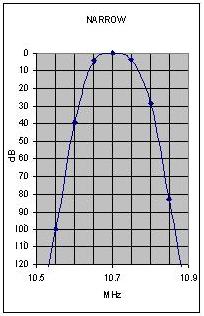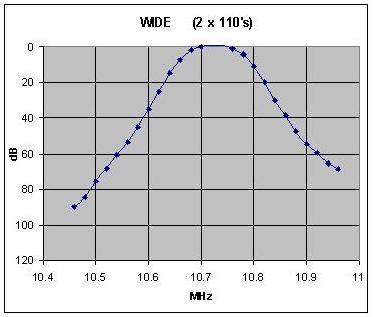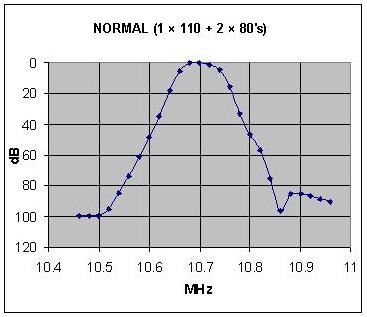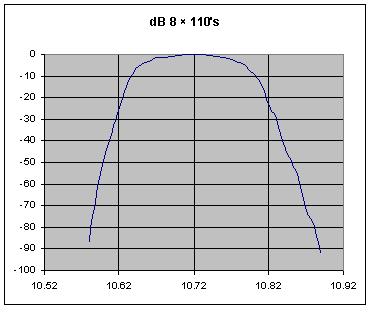

First, the ceramic filters -

IF RESPONSE with the original filters
The individual filter types are 260kHz (-3dB) for 'wide', 170kHz for 'normal' and 150kHz 'narrow'. In combination, these give the responses shown here
IF RESPONSE achievable with modified filters
A brief note on choosing the KT-6040 ceramic filters for 'Dx-ing'
There is also a full analysis of the IF filters of the KT-6040, measured individually and combined arithmetically to show the amplitude response of the three selectivity settings, both with the original filters and replaced with narrower units. The results are presented numerically and graphically in an excel file, and you can play about with the data and the graphs.
It is interesting to consider what IF response would result from 8 × 110kHz filters throughout in a receiver. This graph was derived from measurements on 8 different units. Note that there is a distinct 'offset' of about 20kHz in this filter set, which would ideally require a compensating offset adjustment of the PLL Local Oscillator (which has been covered by Brian Beezley)
The effects on the audio and receiver selectivity of using these narrow filter settings PROBLEMS with the ROTARY ENCODER for the tuning control
Erratic tuning due to wear on the encoder is a recurring topic among users of the 6040. This component was not intended for prolonged use, and is an inexpensive type of component increasingly found on consumer equipment.
Suitable modifications will cure the problem if you are prepared to dismantle the 6040. Replacement components are readily available, so replacement is not a problem, but adding 2 capacitors will usually restore operation
To avoid unnecessary over-use, try to use the encoder and the presets sensibly. Store enough frequencies to divide the band for quick tuning. I recommend storing 88 - 90 - etc - 104 - 106 in presets 1 - 2 - etc - 9 - 10, and all favourite quiet channels in subsequent presets.
Gentle cleaning with a very small drop of 'Sevisol' cleaning fluid will also help, but this also requires dismantling.
Gain Setting adjustments:
Three gain-setting adjustments are provided to set the IF gain in 'Wide', 'Normal' & 'Narrow' modes. These were intended for calibrating the 'S'-meter, but they should be set for maximum gain for Dx-use. Only VR1 'Wide' has a significant gain adjustment range, and should be set fully counterclockwise for maximum gain. VR2 + 3 work the opposite way for 'Normal' & 'Narrow', but they do not affect the overall sensitivity, so set them to give the same 'S'-meter reading as for 'Wide'.
Audio Muting
The muting can be turned off by cutting the W27 link.
The 'channel step' & 'de-emphasis' switches are not normally fitted in European models. To change the de-emphasis to 75µs, fit links in the positions shown above. The step sizes are fixed in firmware and cannot be changed. Presumably there was different firmware for a switchable model, if that was ever produced
Adding an S-meter
The signal strength indicator on the KT-6040 display gives only a token indication of signal levels, so it is well worth adding a simple S-meter with an external moving-coil meter
Alignment
See the valuable alignment information from Todd Emslie. See also Todd Emslie's TV DX site
J.Hardstone - Last updated 6 Nov.2009







are discussed further in the KT-6040 audio page

